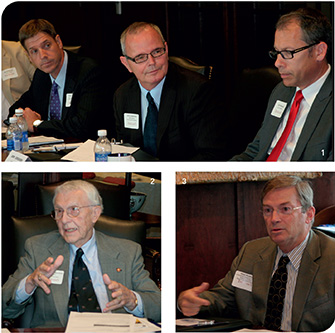
1. Assembly chairmen Paul Holewinski, left, and Jerry Jorgensen, center, directed a wide-ranging, two-hour discussion. | 2. Gen. Robert Arter cited the social disconnect between the 1 percent who serve in the military and the civilian population at large. | 3. Many veterans, said Mike Hockley, are experienced in making critical decisions under pressure, skills that are highly valued in the workplace as well as on the battlefield.
Obviously not all veterans re-entering the civilian work force have the level of experience that General Arter does, but many have similarly intense experience. “You have captains who have been in the Army three or four years commanding a hundred people in combat,” said Mike Hockley, a West Point grad and retired lieutenant colonel, now a law partner with Spencer Fane Britt and Browne. “They are making life-and-death decisions every day. Those people who are getting out of the Army have a lot to contribute.”
Just what veterans can contribute and how local business can access their talents was the subject of the day’s discussion. Ably chairing the assembly were Paul Holewinski, CEO at Dickinson Financial and Armed Forces Bank, and Jerry Jorgensen, senior vice-president at Park University and a retired colonel himself.
Active Measures
There has been much done already to integrate veterans into civic life, and Paul Holewinski called on his colleagues to volunteer some examples.
One area in which Armed Forces Bank has been proactive is in the hiring of military spouses, said Don Giles, bank president. In fact, some 30 percent of the bank’s retail personnel are veterans and military spouses. With 60 outlets at various military installations in 17 states, the fact that military families move frequently can actually be beneficial to both the spouse and the bank. Giles told the story of one woman who was hired in 1991, worked at seven or eight different military installations as her husband moved around the country, and now is back in Leavenworth as the bank’s No. 2 person in operations.
“Everyone is aware of the draw down that’s coming,” said Brett Rosene, the transition services manager for Fort Leavenworth. “A lot of people have been given their walking papers, and even those that haven’t are now starting to think that they need to look at another career.” Every transitioning military person comes through Rosene’s program. He works closely with the SBA and other organizations and holds three major job fairs a year, the next coming up in August.
Bob Ulin, chairman and CEO at the Center for Transitional Leadership, complements the work Rosene does at Fort Leavenworth. In fact, he was teaching a class the next day to a group of retiring military personnel on salary and benefit negotiation—“something military people never have to do.” Ulin stressed the importance of high level networking for “the jobs that never show up in the ads.”
Park University, noted Jerry Jorgensen, recently started a Warrior Center in its career development office to work with veterans on resume writing, interviewing, and other job related skills.
Dean Vakas, the associate vice president at Park University and a retired colonel, added that Park has a very
strong military connection. The university operates 40 campus centers around the country, 34 of which are on military bases. The vast majority of center directors are either retired military or spouses of active duty military.
“In reality,” said Vakas, “Park is primarily a veteran organization.” The university has a large number of military students who are active duty, typically senior NCOs pursuing an undergraduate degree. In the past two years, however, the student demographic has shifted from active duty to veteran.
Florian Rothbrust, senior vice president at J.E. Dunn Construction, noted that his company operates in 27 different offices and hires veterans whenever it can. “The military guys know how to manage time, people, and assets,” said Rothbrust. “These are three critical things that if you cannot do, you are going to fail.”